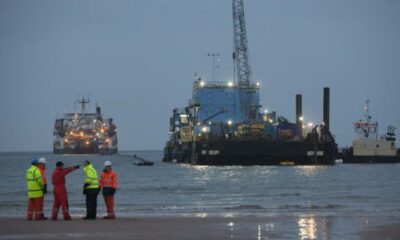

Energy
2030 To See Rapid Energy Storage Growth
Energy storage is poised to grow rapidly in the UK towards 10GW in the 2030’s – but action is needed to align the technology with market and policy signals if this potential is to be realised.
The findings in a new report: “Energy storage – towards a commercial model” was launched today at an event held in London by energy experts Regen SW, in association with sustainable finance pioneer Triodos Bank, leading low-carbon developer Green Hedge Energy, and UK law firm TLT.
The report is part of the ‘Pathway to Parity’ series which has been developed by Regen SW which explores the alternative business models that will make clean energy the subsidy free backbone of our electricity system.
Philip Bazin, Environment Team Lead, Triodos Bank UK, commented: “It is clear from the advances made in other countries and now the UK that proven sustainable electricity storage solutions exist and that their cost is fast reducing. What we now need to make these solutions more financeable is a clear, long term policy and regulatory framework to support the demand for these solutions and create an exciting sizeable new market in the UK.”
By the end of 2015, Triodos Bank and its climate and energy investment funds were financing 358 projects across Europe, contributing to a generating capacity of 2,100 MW of energy. Triodos Bank has over 20 years’ experience of investing in renewable energy, and Philip believes that energy storage investment and research is imperative to fully realise a sustainable future.
Energy storage is developing rapidly and the flexibility it provides can reduce the need for expensive new energy generation projects.
“The deployment of sustainable energy storage solutions in the UK is one of the key pillars that is required to achieve an energy system that is 100% sustainable – a low carbon, resilient and balanced energy system. It’s essential that financial institutions work closely with developers and policy makers to create a conduit for energy storage technology that will support the wider strength of renewable energy production.”
Johnny Gowdy, Regen SW Director, commented: “Energy storage is developing rapidly and the flexibility it provides can reduce the need for expensive new energy generation projects. However, developers and investors face an unsolved ‘Rubik Cube’ of technologies, regulatory frameworks, revenues and costs.
“In the short term battery storage projects will tend to focus on rapid response services to support the network. As costs fall, storage will play a key role in providing reserves of energy to balance supply and demand and could become ubiquitous in our homes, workplaces and in transport. A UK energy storage sector in excess of 10 GW power capacity in the 2030’s is achievable.
“The government will shortly be consulting on taking forward the National Infrastructure Commission ‘Smart Power” report. This is a key opportunity to align policy and regulation to enable a more flexible power system with storage at its heart”.
Niels Kroninger, Managing Director, Green Hedge Energy, commented: “Like a Swiss Army Knife, energy storage can deliver a wide variety of critical services. Unlike a Swiss Army Knife, already today it is cheaper than most alternatives, which means that we look forward to strong deployment without the need for any new subsidies. By making the different revenue streams work together better, BEIS, Ofgem and National Grid could eliminate risks to investors in storage, which in turn could deliver even greater savings to consumers.”
Maria Connolly, Head of Energy & Renewables and Real Estate, TLT commented: “Energy storage presents a real opportunity for the renewables sector. There is a need to balance the grid and ensure electricity is available at the right time and cost, and the recent EFR tender has shown how much investment is being put into rapid response technology.
In the short term we could see Behind the Meter (BtM) storage making a significant impact on the electricity grid. Large power users are starting to look at taking advantage of BtM and the revenue streams and cost savings available to them. Longer term, co-locating storage with other renewable technologies including wind or solar developments could be part of the solution which make projects of this nature commercially viable in a subsidy free environment.”
The report comes as National Grid announced it has contracted with eight storage projects for total of 201 MW of capacity to provide services to help manage the network.
To see the full report visit: https://www.regensw.co.uk/7283018298372873/wp-content/uploads/2016/09/P2P-Energy-storage-Towards-a-commercial-model-DIGITAL-V.2-Singles.pdf


 Environment9 months ago
Environment9 months agoAre Polymer Banknotes: an Eco-Friendly Trend or a Groundswell?

 Environment11 months ago
Environment11 months agoEco-Friendly Home Improvements: Top 7 Upgrades for 2025

 Features8 months ago
Features8 months agoEco-Friendly Cryptocurrencies: Sustainable Investment Choices

 Features10 months ago
Features10 months agoEco-Friendly Crypto Traders Must Find the Right Exchange





























